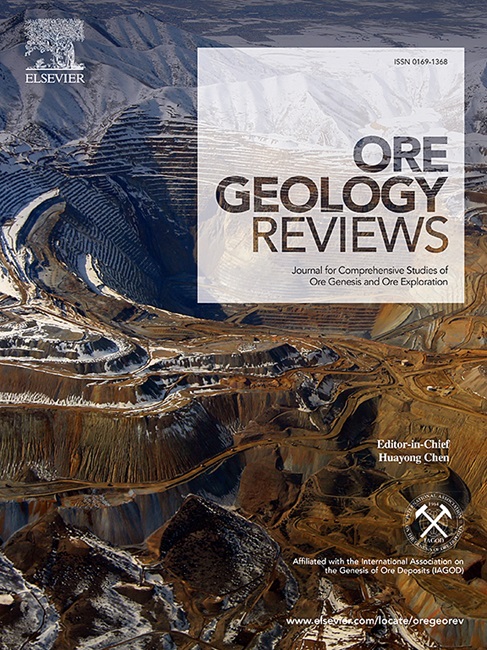华北克拉通中条山宋家山钴铁矿床硫化物的地质年代、原位元素和硫同位素:对钴成矿和矿石成因的启示
IF 3.2
2区 地球科学
Q1 GEOLOGY
引用次数: 0
摘要
宋家山 Co-Fe 矿床位于中条山东南边缘 "铜山天窗 "的中部,赋存于古新生代宋家山组的火山-沉积岩系中。矿体的空间分布受南北走向岩石单元的控制。根据显微观察,主要矿石矿物包括磁铁矿、黄铁矿、黄铜矿、卡罗来石和菱铁矿,而煤矸石矿物包括石英、方解石、绢云母和绿泥石。钴铁矿石具有块状、条带状、散布状和细脉状的质地,母岩的蚀变包括硅化、绢云母化、黄铁矿化、碳酸盐化和绿泥石化。宋家山矿床的成矿过程分为三个时期:沉积期、变质期和热液期。热液黄铁矿(Py-III)中的钴含量从1.05%到3.75%不等,平均为2.45%。黄铁矿中的钴分布均匀,且与铁成反比,表明黄铁矿中的钴同构取代了铁。黄铁矿的特征钴/镍比变化很大,从 0.1 到 1000 不等,反映了沉积、变质和热液成矿的各种成因类型,主要成矿期主要与热液活动有关。主岩的锆石U-Pb地质年代和含钴黄铁矿的Re-Os等时线表明,钴矿化主要发生在2100Ma∼。硫化物的原位 S 同位素分析显示了两个峰值 δ34S 值,分别为 5-9 ‰ 和 12-16‰。我们认为前一个值反映了火山和海洋硫酸盐源的混合,而后一个值则主要归因于海洋硫酸盐源。所有δ34S值均低于新生代海相硫酸盐的值(15-20‰)。据此,我们推断热化学硫酸盐还原在海相硫酸盐还原中起着关键作用,宋家山矿床富钴矿体的形成经历了初始沉积、变质-变形、热液叠印等过程。从成因上看,我们认为宋家山矿床属于沉积-变质热液叠加型Co-Fe矿床。本文章由计算机程序翻译,如有差异,请以英文原文为准。
Geochronology, in-situ elements and sulfur isotopes of sulfides from the Songjiashan cobalt-iron deposit in the Zhongtiao mountains of North China Craton: Implications for cobalt occurrence and ore genesis
The Songjiashan Co-Fe deposit in the central part of the “Tongshan skylight” on the southeastern edge of the Zhongtiao Mountains is hosted by the volcanic-sedimentary rock series of the Paleoproterozoic Songjiashan Group. The spatial distribution of the orebodies is controlled by south-north trending rock units. Based on microscopic observations, the dominant ore minerals included magnetite, pyrite, chalcopyrite, carrollite, and linnaeite, while gangue minerals comprised quartz, calcite, sericite, and chlorite. Cobalt-iron ores had massive, banded, disseminated, and veinlet texture, and alteration of the host rocks included silicification, sericitization, pyritization, carbonation, and chloritization. Mineralization processes of the Songjiashan deposit were grouped into three periods: sedimentation, metamorphism, and hydrothermal. The Co concentrations in hydrothermal pyrite (Py-III) varied from 1.05 % to 3.75 %, with an average of 2.45 %. Cobalt in pyrite was homogeneously distributed and inversely correlated to Fe, indicating that Co isomorphically replaced Fe in pyrite. The characteristic Co/Ni ratio of pyrite varied greatly, ranging from 0.1 to 1000, reflecting various genetic types of sedimentation, metamorphism, and hydrothermal mineralization, with the main mineralization period primarily related to hydrothermal activities. Zircon U-Pb geochronology of the host rock and Re-Os isochron of Co-bearing pyrites indicate that Co mineralization mainly occurred at ∼2100 Ma. In-situ S isotopic analysis of sulfides reveals two peak δ34S values of 5–9 ‰ and 12–16 ‰. We interpret that the former value reflects the mixing of volcanic and marine sulfate sources, while the latter value is mainly artributted to marine sulfate sources. All δ34S values were lower than those of Proterozoic marine sulfates (15–20 ‰). Accordingly, we infer that thermochemical sulfate reduction plays a key role in marine sulfate reduction, and that the formation of Co-rich ore bodies in the Songjiashan deposit have undergone processes of initial sedimentation, metamorphism-deformation, and subsequent hydrothermal overprinting. Genetically, we suggest that the Songjiashan deposit belongs to a sedimentary-metamorphic hydrothermal superposition type Co-Fe deposit.
求助全文
通过发布文献求助,成功后即可免费获取论文全文。
去求助
来源期刊

Ore Geology Reviews
地学-地质学
CiteScore
6.50
自引率
27.30%
发文量
546
审稿时长
22.9 weeks
期刊介绍:
Ore Geology Reviews aims to familiarize all earth scientists with recent advances in a number of interconnected disciplines related to the study of, and search for, ore deposits. The reviews range from brief to longer contributions, but the journal preferentially publishes manuscripts that fill the niche between the commonly shorter journal articles and the comprehensive book coverages, and thus has a special appeal to many authors and readers.
 求助内容:
求助内容: 应助结果提醒方式:
应助结果提醒方式:


